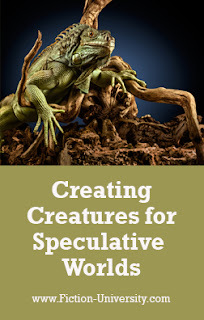Janice Hardy's Blog, page 17
August 21, 2021
WIP Diagnostic: Is This Working? A Closer Look at Starting with Action in an Opening Scene
 Critique by Janice Hardy, @Janice_Hardy
Critique by Janice Hardy, @Janice_Hardy WIP Diagnostics is a weekly column that studies a snippet of a work in progress for specific issues. Readers are encouraged to send in work with questions, and we diagnose it on the site. It’s part critique, part example, and designed to help the submitter as well as anyone else having a similar problem.
If you're interested in submitting to WIP Diagnostics, please check out these guidelines.
Submissions currently in the queue: Five
Please Note: As of today, critique slots are booked through September 25.
This week’s questions:
I’d appreciate your opinion on whether this opening captures the reader’s attention without losing them wondering what’s happening, when and where. I’ve had some critiques mention that starting in the action has to ‘be earned’, so I’d be interested in your take on it. I’m trying to tell less and show more without leaving too much out.
Market/Genre: YA Post-Apocalyptic
On to the diagnosis…
Continue ReadingWritten by Janice Hardy. Fiction-University.com
Published on August 21, 2021 06:46
August 19, 2021
Forbidden Formats: The Risks and Rewards of Uncommon Narrative Structures
 By Bonnie Randall
By Bonnie RandallPart of The How They Do It Series
JH: Not every story needs to be told in the Three Act Structure. Bonnie Randall shares three examples of narrative structures that defy convention—and still work.
Every fiction writer from veteran to novice knows there’s a collection of “don’ts” when writing.
Don’t use adverbs
Don’t use adjectives
Don’t use any tag other than ‘said’.
Don’ts abound in narrative structures, too, (how the story is delivered). Nevertheless, this summer I’ve read several bodies of fiction that used ‘Forbidden Formats’ with outstanding results. Let’s unpack a few and analyze why they worked—and how they can be utilized in your fiction.
Continue ReadingWritten by Janice Hardy. Fiction-University.com
Published on August 19, 2021 03:00
August 17, 2021
11 Reasons Why You Should Submit Your Short Stories to Anthologies
 By Rayne Hall, @RayneHall
By Rayne Hall, @RayneHallPart of the Focus on Short Fiction Series
JH: Submitting a short story to an anthology has a lot of benefits. Rayne Hall shares 11 reasons why you should give one a try.
Getting short stories published in anthologies (collections of stories by multiple authors) can be a big stepping stone in your fiction writing career.
Here are the reasons why you should try:
1. As a Yardstick
If an anthology editor selects your story, it proves that your writing is good enough to be published. New writers can't judge the quality of their own writing, and friends and family aren't unbiased judges either. So if an independent editor chooses your piece over others, it confirms that your writing has reached an important threshold. Of course, some anthologies have higher standards and are more difficult to get into than others. While getting accepted by any anthology is great for a novice, seasoned writers will seek to get into one of the top anthologies of their genre.
Continue ReadingWritten by Janice Hardy. Fiction-University.com
Published on August 17, 2021 03:00
August 16, 2021
Why Ask Why? Because Your Readers Will
 By Janice Hardy, @Janice_Hardy
By Janice Hardy, @Janice_Hardy Making readers wonder is a good thing—unless they have no clue why your characters are acting as they do, or your world makes no sense.
It’s easy to think plotting is all about the what—after all, the plot is what happens to your characters. But while the what is important to how the story unfolds, the why is what’s driving that story to unfold in the first place. What without why is just action with any motivation.
A strong plot will combine both the what and the why.
A weak novel often has characters who are acting only because plot says they need to—there’s no plausible reason for them to behave that way. And worse, none of their actions have consequences that force them to act again so the whole GMC plot cycle can continue. Your scenes get stuck and you aren’t sure why, they feel flat and it’s hard not to skim, and you probably have a nagging feeling the scene isn’t doing enough. You know what happens, but not why.
Continue ReadingWritten by Janice Hardy. Fiction-University.com
Published on August 16, 2021 03:00
August 14, 2021
WIP Diagnostic: Is This Working? A Closer Look at a Historical Fiction First Page
 Critique by Maria D'Marco
Critique by Maria D'Marco WIP Diagnostics is a weekly column that studies a snippet of a work in progress for specific issues. Readers are encouraged to send in work with questions, and we diagnose it on the site. It’s part critique, part example, and designed to help the submitter as well as anyone else having a similar problem.
If you're interested in submitting to WIP Diagnostics, please check out these guidelines.
Submissions currently in the queue: Six
Please Note: As of today, critique slots are booked through September 25.
This week’s question:
Does this opening scene work?
Market/Genre: Historical Fiction
On to the diagnosis…
Continue ReadingWritten by Janice Hardy. Fiction-University.com
Published on August 14, 2021 04:55
August 13, 2021
A 9-Step Plotting Path to a Stronger Novel
 By Ann Harth, @Annharth
By Ann Harth, @Annharth
Part of the How They Do It Series
JH: There are as many ways to plot as there are to write. Ann Harth shares a character-focused process that helps her visualize her novel's plot.
Ann Harth writes fiction and non-fiction for children and adults. Strong, interesting female characters creep into many of her books, and many arrive with a sense of humor. She taught writing for the Australian College of Journalism for eight years before taking the leap into freelance writing and structural editing work.
Ann has had a number of fiction and non-fiction children’s books published in Australia and the UK and over 130 short stories sold internationally. When not tapping the keys, Ann stuffs a notebook into her pack and searches for remote places to camp, hike or explore.
Website | Goodreads | Facebook | Twitter |
Take it away Ann...
Continue ReadingWritten by Janice Hardy. Fiction-University.com
Published on August 13, 2021 03:51
August 11, 2021
Creating Creatures for Speculative Worlds
 E. J. Wenstrom, @EJWenstrom
E. J. Wenstrom, @EJWenstromPart of the How They Do It Series
JH: The creatures that inhabit our novels should make sense and feel as real as our worlds. E.J. Wenstrom shares tips on how to create creatures that enhance our story.
E. J. Wenstrom believes in complicated heroes, horrifying monsters, purple hair dye and standing to the right on escalators so the left side can walk. She writes dark speculative fiction for adults and teens, including her new release, a young adult dystopian novel titled Departures . When she isn’t writing fiction, E J. Wenstrom is a regular contributor to DIY MFA and BookRiot, and co-hosts the FANTASY+GIRL Podcast.
Website | Twitter | Facebook | Instagram | Newsletter | Podcast
Take it away EJ…
Continue ReadingWritten by Janice Hardy. Fiction-University.com
Published on August 11, 2021 03:00
August 9, 2021
Want a Tighter Point of View? Ditch the Filter Words in Your Novel
 By Janice Hardy, @Janice_Hardy
By Janice Hardy, @Janice_Hardy If you’re using filter words in your writing, you might be inadvertently shoving readers out of your story.
No matter who your narrator is—a tight first person or an omniscient third—readers see the novel through their eyes. Sometimes this filter is invisible and readers don't notice any narrative distance between them and the point of view character. Other times, the filters are obvious and readers feel the wall between them and the characters. One narrative style looks through the eyes of the point of view character, the other looks at the point of view character.
Readers (and writers) have a variety of tastes when it comes to narrative distance and point of view. Some readers want to be inside a character’s head and part of the action, and some prefer to sit outside the action and watch. Where you put your narrator affects how the novel reads, and filter words—or lack thereof—helps you position that narrator.
Continue ReadingWritten by Janice Hardy. Fiction-University.com
Published on August 09, 2021 03:00
August 8, 2021
WIP Diagnostic: Is This Working? A Closer Look at Drawing Readers into Your Novel
 Critique by Janice Hardy, @Janice_Hardy
Critique by Janice Hardy, @Janice_Hardy WIP Diagnostics is a weekly column that studies a snippet of a work in progress for specific issues. Readers are encouraged to send in work with questions, and we diagnose it on the site. It’s part critique, part example, and designed to help the submitter as well as anyone else having a similar problem.
If you're interested in submitting to WIP Diagnostics, please check out these guidelines.
Submissions currently in the queue: Seven
Please Note: As of today, critique slots are booked through September 25.
This week’s questions:
1. Does this work?
2. Would a reader want to read on and find out what happens next?
Market/Genre: Science Fiction Political Thriller
On to the diagnosis…
Continue ReadingWritten by Janice Hardy. Fiction-University.com
Published on August 08, 2021 05:06
August 6, 2021
3 Mixed-Up Writing Goofs You Might Be Making
 By Aly Brown, @AlyConnerBrown
By Aly Brown, @AlyConnerBrownPart of the How They Do It Series
JH: Using the wrong word in our writing is not only embarrassing, but can hurt our novel's chances at success. Aly Brown shares a few tips on how to remember these often-goofed words.
Aly Brown is a newspaper editor and author represented by BookEnds LLC. She recently inked a deal with Feiwel & Friends / Macmillan for a nonfiction middle grade book on Alvin Submersible called The Last Unexplored Place on Earth. Release date 2023.
Website | Twitter | Grammar Chicken
Take it away Aly...
Continue ReadingWritten by Janice Hardy. Fiction-University.com
Published on August 06, 2021 03:23



